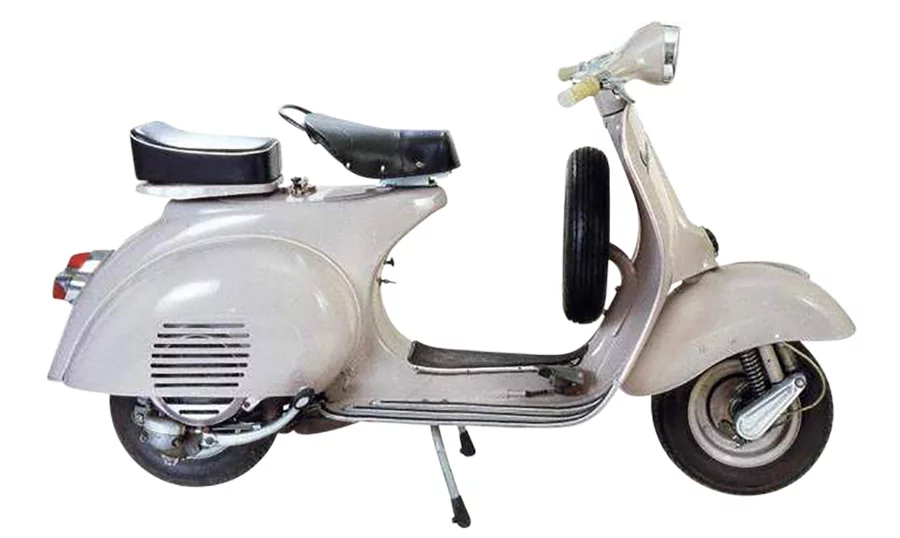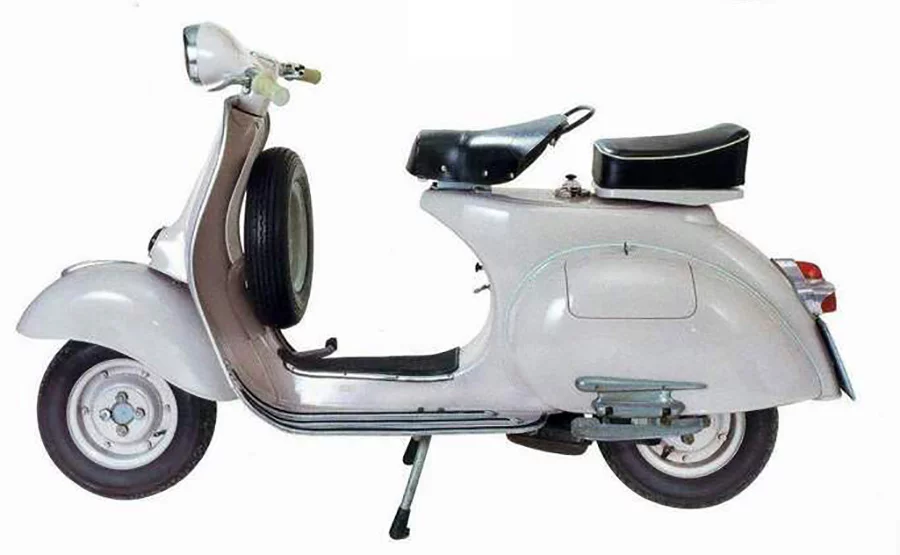
1958 - VESPA 125 (VNA-VNB) from 1958
First Vespa Largeframe
The era of the begins with the Vespa 125 from 1958 (VNA) Largeframe-Models. The most striking feature is the disappearance of the flap in the passage under the bench.
Overall, the frame is not only narrower, it has also become significantly lighter. Thanks to the new production process, the body is now made from two sheet metal half-shells. The front fender is also made up of two parts and welded in the middle. Characteristic features that can now be found on the Vespa. The motor is also much more compact because the rocker is integrated into the housing. Other details, such as the kick starter mechanism and switch box, should prove to be groundbreaking innovations.
With the VNA, the steering head is divided and all controls are freely accessible after removing the upper steering head cover. A very practical solution, especially since neither the speedometer nor the speedometer cable are in the way, as these are not yet part of the standard equipment. The brake drums are made of aluminum and have a cast-iron inner ring and the moped has 8-inch tires. The vehicles are delivered with a single saddle and luggage rack as standard. The saddle cover is dark green, the Vespa lettering on the leg shield is dark blue.
The scooters with the frame code VNA1 were delivered in gray (Max Meyer Code 15046). The frame abbreviation VNA2 was changed to a light beige (Max Meyer 15099).
1960 VNB1T and 1961 VNB2T
With the model years 1960/61, the VNB1T and the VNB2T, the cosmetically slightly revised successor, are presented. The lettering on the leg shield is now a little smaller, the saddle is dark blue and the rear light of the GS 150, which is painted in the vehicle color, is the most striking feature on the outside. In terms of color, both VNB1 and VNB2 are light gray-blue (Max Meyer Code 1.298.8840). The VNB2 model is easy to recognize by the - now standard - rectangular speedometer with a white dial.
There is no more battery and the taillight has 6V / 5W instead of the 6V / 3W. From frame number 9001, a stand with a larger diameter and four instead of two screws is installed for fastening. Technically, the VNB is now also supplied with a motor that works according to the rotary valve principle, which was previously introduced with the Vespa 150 (VBA1T) from 1959. The great advantage of these engines is that the carburettor is located on the engine housing directly above the crankshaft, which means that the lower connecting rod bearing and the crankshaft drive are very well lubricated. A measure thanks to which the proportion of oil in the mixture can be reduced to 2%.
1962 VNB3T & VNB4T
Whoever says VNB2 will also say VNB3T. Piaggio did this in 1962 and presented an unchanged successor under the bonnet. The changes were mainly made in cosmetic terms, so many features of the 150 models are incorporated. The handlebar head can no longer be divided and is made of cast aluminum with a mount for the small, square speedometer, as it is known from the previous model. However, the diameter of the headlight grows to 115 mm. The brake pedal is the same as on the 150, made of highly polished aluminum with a black brake pedal rubber. Vespa lettering and saddle come in a dark blue. The rear light is no longer painted, but chrome-plated. Instead of the baseboards on the center tunnel, the mat is now mounted with decorative strips on the side. The front fender is shaped slightly differently than on the previous model and now has beads on the sides. The leg shield is flanged with an aluminum slotted tube. With that too 1962 featured VNB4T doesn't change that much. The proven engine is retained and the frame only changes in the area of the license plate attachment, here the frame is now angular. The scooter is delivered in a light gray (Max Meyer 1.298.8707). The wheelbase is 2 cm shorter. The rear brake pads are no longer attached to an overlapping bolt, but have two bolts. The side panels are now upgraded with decorative strips.
1963VNB5T
1963 becomes with the VNB5T for the first time a motor with a 4-speed gearbox was installed. The overall gear ratio has remained the same, but the gearbox is more closely graduated. With the VNB6T, only minor changes were made from 1964 onwards. In this way, the nuts of the stud bolts of the wheel mounting are reinforced (from 8 to 10 mm). In addition, the wheel nuts no longer have a weld. The taillight is the super one. From a technical point of view, the compression of the 4-speed engine is increased from 7,2: 1 to 7.7: 1. This increases the power from 4,6 to 5,12 hp.





